Who Is The Greatest Driver Of All Time?
Who do you consider to be the world’s best ever driver? Ayrton Senna would obviously rate a mention, and here in Australia we can be rightly proud of our home grown heroes, such as
Jack Brabham,
Alan Jones,
Peter Brock and
Allan Moffat. But there is one man that, above all others, seems to be the one against which all others are judged.
That man is Argentina's Juan Manuel Fangio, the five-times World Champion who did not make his bow in European Grand-Prix racing until he was 37, and who finally retired at the end of 1958 when he was 47. Over his seventeen-year career as a racing driver, Fangio competed in over 180 races in 23 countries and won eighty of them.
San Juan's Day
Fangio was born on 24 June 1911 - San Juan's day, hence his name - at Balcarce, a small town 200 miles from Buenos Aires. His father, Loreto Fangio, an Italian immigrant, was a house-painter by trade. At school, young Juan Manuel was not a brilliant pupil, but a terrific footballer. He earned the nickname 'El Chueco' - bandy legs - for his magnificent goals.
Aged ten, Fangio began his interest in items mechanical. He did odd jobs after school for a local garage man. Later, his father found him employment at Senor Viggiano's garage. At seventeen, by now a qualified mechanic, Fangio was approached by one of Viggiano's customers, Senor Ayerza, to be his riding mechanic in a race for
Model T Fords. Fangio readily accepred and managed to participate without his parents knowledge. Initial fear turned to exhilaration and a thirst for more.
Partnering with Jose Duffard
After a lengthy bout of pneumonia, during which he almost died, Fangio was called up for military service. Upon his return to Balcarce, he obtained a loan from his father and went into partnership with his friend, Jose Duffard, to start a small garage. In December 1934, however, there came the chance Fangio had been waiting for: a borrowed
Ford Model T for him to race. It was an inauspicious debut; 23-year-old Juan Manuel Fangio seized a big-end and had to fix it for nothing before returning the machine. The bug had well and truly bitten now and Fangio began collecting parts to build his own Ford Model T.
 Fangio, relaxed but focused, at the start of a F1 race.
Fangio, relaxed but focused, at the start of a F1 race.
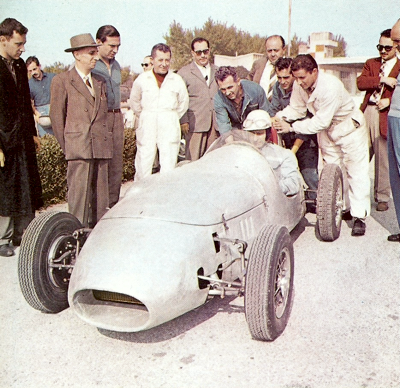 Fangio takes time out during his busy F1 schedule to test a Formula Junior Stanguellini at Modena in 1958.
Fangio takes time out during his busy F1 schedule to test a Formula Junior Stanguellini at Modena in 1958.
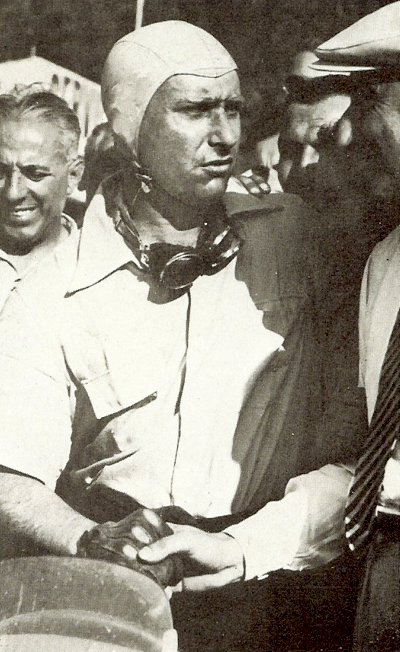 Fangio, during the early part of his career (evident by the cloth hat).
Fangio, during the early part of his career (evident by the cloth hat).
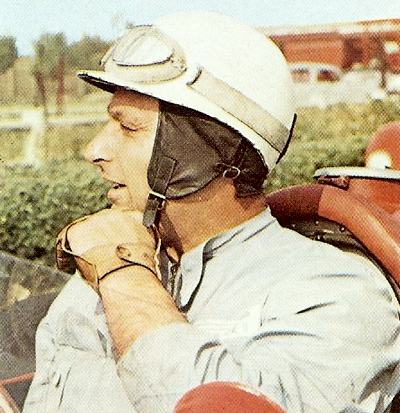 Fangio pictured in 1957.
Fangio pictured in 1957.
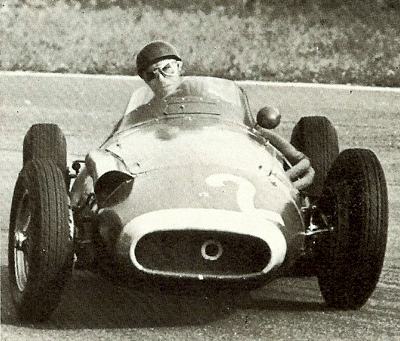 Fangio pictured in 1957.
Fangio pictured in 1957.
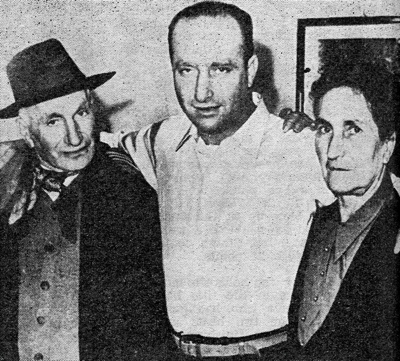
A rare photograph of Fangio with his parents in his home town of Balcarce in the Argentine.
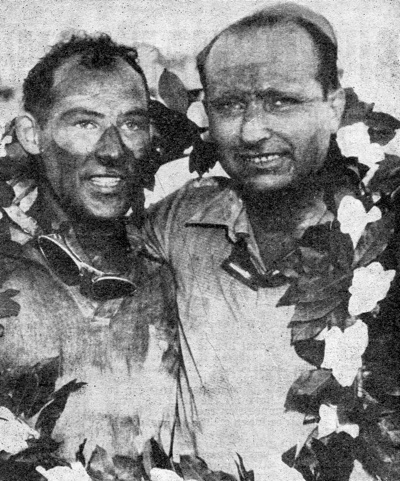
First and Second Place for Fangio and Sterling Moss in the 1955 Buenos Aires GP, a one-two victory that would set the pattern for the season.
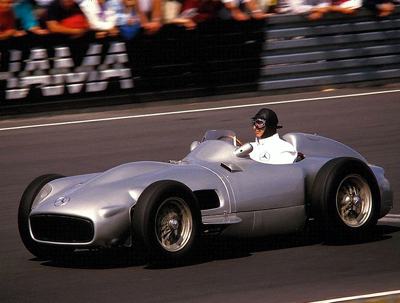
Fangio appearing at the 1986 Old-Timer GP at the Nurburgring.
|
The Gran Premia Nacional
After some races with the Model T, Fangio built a V8 special, inserting an 85 bhp Ford V8 into a Ford chassis and wrapping the ensemble with a home-made two-seater body. Its first race at Necochea in March 1938 was eventful. Fangio out-accelerated Carlos Arzani's 3.8-litre Alfa Romeo 8C-35
Grand Prix machine off the grid, but eventually power told and Arzani shot ahead to win. Fangio was third. The highlight of the Argentinian calendar was the Gran Premia Nacional, an annual race of around 6000 miles, run in stages of between ten and fifteen hours each, for modified production cars.
The Gran Premio
Fangio could not afford one of the cars used in this classic event, but he competed as a riding mechanic, in 1938, for Luis Finocchietto; they finished seventh. In September 1939 Fangio's supporters in Balcarce organised a collection to buy him a car - a Chevrolet coupe. In the Gran Premio, held in flooded conditions, Fangio was fifth despite an accident. This secured him a place in the official Chevrolet team and he won the race in 1940. For the next two years, Fangio won many major endurance races with his Chevrolet, but racing ceased in 1942, owing to the war, and Fangio took a job as a taxi driver.
Fangio had kept his reactions sharp by relentlessly practising on the roads, but when racing resumed in 1947 he wondered if, at 36, he was too old to be a serious contender. Far from it. His results with track and road-racing Chevrolet specials resulted in the loan of a European car in a series of international races run early in 1948. Driving a Maserati 4CL and a Simca-Gordini, Fangio impressed the visiting Europeans. The Argentine Government, headed by Juan Peron (a motor-racing fanatic), decided to send a group of drivers to Indianapolis and then to Europe in the summer of 1948 to see the current trends for themselves.
Amedee Gordini sends Fangio a Telegram
Fangio received a 'telegram from Amedee Gordini, asking him to drive at Rheims. However, the little Simca-Gordinis were outclassed and Fangio's European debut was hardly noticed. For the international races in I949, the Argentine Automobile Club lent Fangio an old Maserati 4CL and later a brand new 4CL T/48 model. With the latter he scored a great victory; beating all the European aces, Fangio won the Mar del Plata Grand Prix. A few days later came news that the club were to send Fangio and Benedicto Campos to race in Europe. Admittedly, the Argentine team chose the lesser Grands Prix, but their jubilation knew no bounds when Fangio's blue-and-yellow Maserati 4CL T/48 won at San Remo, Pau, Perpignan and Marseilles.
The Monza Autodrome Cup
Then funds began to run low and when Fangio retired with
piston failure on the first lap of the Belgian Grand Prix; it was utter disaster. However, a textile firm offered financial support, a new Formula Two Ferrari 166C was ordered and Fangio put things right by winning the Monza Autodrome Cup with it, beating the three works-entered cars. The prize money from Monza meant that the team's Maseratis could be rebuilt at the works. Fangio won at Albi, but failed at Rheims in both the Formula One and Formula Two races. By the end of July, the cars were in a poor state and Fangio decided to cut his losses and return home.
The World Championship Series
For
1950 the FIA brought new glamour to Formula One racing by instigating the World Championship series. This attracted the Alfa Romeo team back into racing after a year's retirement and they signed up Fangio to partner Giuseppe Farina and Luigi Fagioli. It was the underlining of Fangio's prowess and, to back this up, one of the previous season's Maseratis, plus a Formula Two Ferrari had been prepared for the minor races. After warming-up with a third at Marseilles in the Ferrari and victory at Pau in the Maserati, Fangio made his debut for Alfa Romeo in the non-championship San Remo Grand Prix. He quickly recovered from a poor start to win by a minute in the pouring rain.
Victories followed in the Monaco, Belgian and French Grands Prix plus the non-championship
Grand Prix des Nations in Geneva and the Pescara Grand Prix. Fangio was also third in his first
Mille Miglia, a road race he hated, and participated unsuccessfully in his first Le Mans 24-hour race. Before the final
Grand Prix in Italy, Fangio led the World Championship table with 26 points to Fagioli's 24 and Farina's 22. In the race, Fangio blew-up his engine; he took over Felice Bonetto's Alfa Romeo 158, but broke down yet again. Farina won and took the Championship honours.
Fangio's First Time with Mercedes
In 1951, Fangio was once more contracted to Alfa Romeo for Formula One, although in the early-season Argentine free formula races he had his first acquaintance with Mercedes-Benz, driving their famous pre-war 3-litre W163 model, albeit without success. In Europe, it was Fangio's year: he won the Swiss, European (French) and Spanish Grands Prix to clinch the World Championship for himself, in the face of tough opposition from Ferrari's Alberto Ascari. It was Alfa Romeo's swan-song in Formula One and, for 1952, Fangio signed with Maserati for Formula Two (which replaced Formula One for two years for the World Championship series) and with
BRM for the few (non-championship) Formula One races that remained.
Fangio's year started on top form with six wins in South America in the Argentine Automobile Club's old Ferrari 166C equipped with a 2-litre supercharged engine. The
BRM P15 broke down at Albi and at Dundrod in Northern Ireland, and then came the Monza
Grand Prix on 8 June, the day after Dundrod. Fangio had flown to France immediately after the race, but bad weather caused his flight to Italy to be cancelled. Undaunted, he borrowed a car and drove through the night, arriving two hours before the start of the race.
The Maseratis - Fast but Fragile
Starting his Formula Two Maserati A6GCM from the back of the grid, he began to climb through the field when he lost control and crashed. His car touched a straw bale at Lesmo Corner, slewed all over the road and finally somersaulted in mid-air. Fangio was thrown out, brushing past the branches of a tree to land on the grass. His vertebrae were damaged and he spent 42 days in hospital and five months in plaster. January 1953 saw Fangio back in the cockpit, driving a Maserati A6GCM at the new Buenos Aires Autodrome in the first Argentine Grand Prix. He had lost none of his skill, taking the lead on lap three and holding it until the transmission failed.
The Maseratis were fast but fragile, and it was not until the end of the year, the Italian
Grand Prix in September, that Fangio won a World Championship race with the newer A6SSG model. Highlight of the year, however, was surely his performance in the Mille Miglia when he took his Alfa Romeo Disco Volante into second place, with the
steering only working on one wheel! In 1954, Fangio began the year driving Maserati's new 2
½-litre 250F Formula One car, winning the Argentine and Belgian Grands Prix.
He had signed, however, to drive the new Mercedes-Benz W196 and, when the German team made its debut in the French
Grand Prix in July, Fangio continued his winning run. He added the German, Italian and Swiss Grands Prix to his list, to win his second World Championship with ease. In 1955, it was a repeat performance. He won the Argentine, Belgian, Dutch and Italian Grands Prix to claim the title again. With Mercedes-Benz withdrawing from racing at the end of the year, Fangio moved to Ferrari to collect his fourth World Championship in 1956, but he did not enjoy his season with this team and returned to Maserati for 1957.
I Never Want To Drive Like That Again
His fifth and last World Championship that year was again clear-cut: he won the Argentine, Monaco, French and German Grands Prix, the last being his most famous victory. His Maserati 250F risked rear-suspension failure on the bumpy Nuburgring if it started on full tanks, so Fangio elected to start on half-tanks and stop midway through the race. This he did, but as he set off from a bungled pit-stop, what had been a 27.8 secs lead had evaporated into a deficit of 28 secs. Slowly but surely, Fangio began to overhaul the Ferraris of Peter Collins and
Mike Hawthorn ahead. Breaking the lap record no fewer than nine times, Fangio drove as never before, overtook his rivals and won by 3.6 secs. Afterwards, he revealed that his seat had broken - he had wedged himself in by bracing his knees on the side of the cockpit-and he confessed, 'I never want to drive like that again'.
Captured by Fidel Castro's Guerillas
In I958, now approaching 47, Fangio turned down offers to lead works teams and decided to run as an independent. For the first time since I954, he failed to win the Argentine Grand Prix, finishing fourth with a sick engine; but he won the non-championship Buenos Aires
Grand Prix two weeks later. Fangio hit the headlines during a visit to Cuba for a sports-car race, when he was kidnapped by Fidel Castro's guerillas, to be released safely after the event. After an abortive attempt to enter the Indianapolis 500-mile race (the cars offered were uncompetitive and he withdrew), Fangio came to Europe for the Monza 500-mile race round the banked circuit, for Indianapolis-type machines.
Sadly, his American car retired with fuel-pump problems after establishing good times in practice. Fangio's last race was the French
Grand Prix at Rheims, scene of his first European appearance some ten years before. Driving a new but underpowered Maserati 250F, Fangio was handicapped by an inoperative clutch, but struggled on gamely to finish fourth. Why did Fangio retire? Was it due to the deaths of his great friends and rivals Eugenio Castellotti, Luigi Musso and Peter Collins that year? Had he passed his peak as a driver? It was none of these things. He had fulfilled his ambitions. He had won the World Championship five times and he felt a sixth title would mean little more.
The International Motorsports Hall of Fame
Following his retirement, Fangio was active in assembling automotive memorabila associated with his racing career. This led to the creation of the Museo Juan Manuel Fangio, which opened in Balcarce in 1986. Fangio was inducted into the International Motorsports Hall of Fame in 1990. He returned to the spotlight in 1994, when he publicly opposed a new Province of Buenos Aires law denying driver's licences to those over 80 (which included Fangio). Denied a renewal of his card, Fangio reportedly challenged Traffic Bureau personnel to a race between Buenos Aires and seaside Mar del Plata, a 400 km (250 mi) distance, in two hours or less, following which an exception was made for the five-time champion. Juan Manuel Fangio died in Buenos Aires in 1995, at the age of 84. He was buried in his home town of Balcarce in Argentina.
My Twenty Years of Racing by Juan Manuel Fangio
There have been many books written about Fangio, the majority posthumously. To our mind here at Unique Cars and Parts, one of the best books written about Fangio was penned by the great driver himself. Fangio's own story is of how he became five times World Champion and retired at the height of his career in midsummer of
1958 after a disastrous final appearance at Rheims, France, when the winner,
Hawthorn, refused to humiliate him by lapping the champion at the finish, a thing that had never happened in Europe.
The book, unusually well translated from the original Spanish, was evidently dictated to his friend and manager of many years, Marcello Giambertone, who contributed commentaries of his own where Fangio was being more than usually reticent and modest. Fangio's book became a true inside story told by the man behind the wheel, throwing much new light on what went on behind the scenes of motor racing as well as when the cars were roaring round the circuits. It was made clear, by the very understatement of the writing, that Fangio was not merely almost an automaton of precision and brilliance at the wheel but a driver of keen intelligence who drove with his brains and quickly learned that no driver ever got anywhere by motoring a fraction too fast or by thrashing his engine until it broke up.
Take the time to read the book and you will see Fangi's resemblance to the great
Tazio Nuvolari emerging in a marked degree - the same lion heart in adversity, the same relentless will to press on when winning or losing, when the car was defective or too slow, the same outward calm, the same willingness to drive on the knife edge when necessary, the same utterly complete mastery of the car and, when away from the circuits, the same, quiet, modest, withdrawn manner that made him an absentee from the wilder after-race parties. When Fangio arrived, unknown, in Europe in 1948, his driving showed the tendency to wildness bred by seven seasons of South American hot rod racing, but after he joined the Alfa Romeo team in 1950 after his first season with Ferrari, the new Fangio was revealed and, like Nuvolari again, in his maturity (he was 47 when he retired) he towered a man among boys.
When the car was right, no one could outdrive or even challenge the Old Man. He was an example to all young drivers in his skill and in his never failing courtesy when racing. Every driver who ever raced against him (and sometimes beat him) held him in the highest admiration and affection. Fangio's book - My Twenty Years of Racing - explains why. When first published all those years ago, it was widely considered to be the best book about motor racing in a decade.



